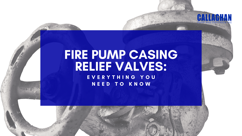When it comes to finding the best fire pump brand, nothing can beat the legacy of Aurora fire pumps NYC.
When it
comes to choosing the right fire pump, the search doesn’t have to be daunting.
You can consider fire pumps for sale that
are built to provide energy efficiency, lower operational costs, and quiet
operation. With Callaghan Pump at your service, we can help you pick the fire
pump you need.
Aurora Fire Pumps NYC
Founded in
1919, Aurora is a trusted supplier of firepumps for sale. The company is devoted to manufacturing an array of fire
pumps and systems for an ever-expanding variety of applications. Prime examples
of such applications include process water supplies, spray booths, cooling
water supplies, and recirculation pumping equipment. Plus, their product range
of fire pumps includes horizontal slurry pumps and packaged fire pump systems.
Why Choose Aurora Fire Pumps?
Wondering why Aurora is better than other fire pump brands? Here are the top reasons that make Aurora fire pumps a great deal for your fire protection system.
Trusted Brand
Over a century of combined legacy in superior pump design and performance makes Aurora a trusted pump brand that stands out from the crowd. Install with confidence without worrying about post-installation issues like unwanted repairs and noises.
Ease of Maintenance
Aurora fire pumps NYC are not only easy to install, but they are also easy to maintain. For example, you can remove the upper half without dismantling piping connections and driver components. This will not disturb the alignment, avoiding additional downtime.
Consistent Water Pressure
Whether you need a fire pump for recirculating water within an industrial building or domestic building, Aurora helps you boost water pressure for a variety of applications. Empowered with helpful digital tools, programs, and technologies, these pumps are made for your water pressure needs.
NFPA-20 Design Fire Pumps
Aurora is an ISO-9001 registered company committed to quality pump manufacturing. It provides superior pump performance and meets NFPA guidelines for selecting and installing fire pumps. This ensures that adequate and reliable water pressure is provided during a fire.
Industry Leader
A leader in
the global fire suppression industry, Aurora is available in a full line of
fire pumps for commercial, industrial, and domestic applications. Whether it’s
a new building, small space, retrofit, or water mist application, Aurora fire pumps NYC provides an
energy-efficient and cost-effective solution to safeguard your fire protection
requirements.
Final Thoughts on Aurora Fire Pumps
From the
selection of Aurora fire pump parts
and related products, let us assist you in finding the best fire pump for your
building. We are a trusted distributor of Aurora
fire pumps NYC and look forward to helping you select the right product.
Our commitment goes beyond our product line and keeps customers updated on the
latest flow technology.
As an authorized master distributor of Aurora Pumps for the
New York metropolitan area, we supply both electric and diesel fire pumps,
handling fire protection for any building. We are also specialized in
high-pressure pumps to help you meet the demands of super high-rise buildings
in NYC. Whether it’s a small inline pump or a larger one, we have got you
covered.
Find Aurora fire pumps for sale.



